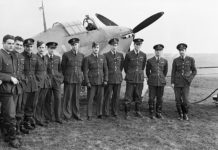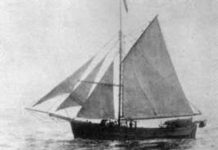Courageous, Samuel Benfield Steele was a Canadian hero, keeping order in the Klondike Gold Rush and leading soldiers in war. He was knighted in 1918.
The direct, serious eyes of Sam Steele were a sign of the strength and leadership to come. Born at Purbrooke, Medonte Township near Orillia, Upper Canada (Ontario) on January 5, 1849, Samuel Benfield Steele’s father, Elmes Steel, was a Captain in the Royal Navy for 30 years, his grandfather and uncle were also military men. Sam’s mother was Anne Macdonald of Scotland. The oldest of six, Sam was home-schooled then attended Toronto’s Royal Military Academy.
Just 17, Sam joined the militia to fight the Fenian Raids. Finding the military to be his niche, “he raised and trained a company for the 31st (Grey) Battalion of Infantry,” said R.C. MacLeod in “Steele, Sir Samuel Benfield,” in Dictionary of Canadian Biography Online. In 1870, the avid young man volunteered for duty with the 1st (Ontario) Battalion of Rifles. The battalion journeyed to Fort Garry and the Red River in Manitoba, disbanding in 1871.
Steele Troop Sergeant Major of the NWMP
Joining the Canadian Permanent Force in Kingston, Sam taught fresh soldiers the art of artillery. “Here in the summer of 1873 he heard that the government intended to create a mounted police force for the North-West Territories,” said MacLeod. Given permission to go, Sam was made Troop Sergeant Major of the newly formed North West Mounted Police and headed back to Fort Garry on the March West in 1874 with a contingent of men, the task to instruct new recruits and break horses. Sam, it was said,, did the hard work of two men.
Appointed Sub-Inspector, Samuel Steele’s first command was the NWMP detachment at Fort Qu’Appell in 1879. As the Canadian Pacific Railway tracks were laid across Canada in the 1880s, Sam was given the difficult mission of patrolling the rail lines and keeping order. A success, he then formed and commanded the Alberta Field Force – Steele’s Scouts – to help put down the North West Rebellion. Promoted to Superintendent, Sam moved on to the Kootenay and then Macleod to control racial problems between whites and natives, and to put an end to wild west crimes.
Order Maintained by Steel in the Klondike
Sam’s most recognized challenge came in 1898 when the glitter of gold lured miners into the Yukon during the Klondike Gold Rush. “He was policeman, magistrate and controller of rations under the very trying times of people seeking their fortunes and unprepared for the weather conditions,” noted the Royal Canadian Mounted Police page on “Sam Benfield Steele.” With nearly 30% of the NWMP under his guidance in the Yukon, Sam was a man of power. And Clifford Sifton, government minister in charge of the Yukon, gave him even more authority: the police unit reported to Ottawa instead of the NWMP heads.
Making use of his unusual influence, Sam required all incoming miners to register their boats and follow water safety rules. “Later that year,” said MacLeod, “he refused to allow anyone into the territory without a minimum quantity of food and money.” While the requirements were for safety, “these actions were blatantly illegal… but they so obviously saved lives that both the miners and Ottawa accepted them.” Sam Steele was the man in control of the Yukon, using little violence, thorough investigation, and a courage of… well… steel. Sam had enough steely courage and wisdom to slow any culprit that may cross his path.
Steele almost Dawson Town Manager
Living at posts near the Chilkoot Pass and the White River, then in the Yukon frontier town of Dawson, Sam was nearly manager of the area. “For two years he was responsible for keeping the peace, running the mails, organizing firefighters and instituting drainage, sewage and garbage disposal and maintaining a pure water supply for Dawson,” according to the Grand Lodge of British Columbia and Yukon.
Transferred out of the Yukon in September 1899, Sam once again took on military duties. The Boer War in South Africa broke out the next month. Taking leave from the NWMP, Sam volunteered immediately, enlisting and training a “group of mounted riflemen named Strathcona Horse,” said the RCMP page. Named the commanding officer, Sam “lead the regiment to great acclaim during the South African War,” noted Edmonton Garrison Public Affairs.
Boer War Ended, World War One Beckoned
When the Strathcona Horse Regiment’s duties in South Africa ended in 1901, Sam accepted a post as divisional commander of the South African Constabulary, much like the NWMP. In 1906, Sam returned to Canada and the next year was appointed Commanding Officer of Military District 13, the area of Alberta and the District of Mackenzie. Four years later, he was transferred to command Military District 10 of Winnipeg.
World War One loomed, and though Sam was in his mid-sixties, he eagerly took on command of the 2nd Canadian Division. He had been promoted the year before to the high rank of Major-General. Considered too old and inexperienced with large military command, Sam trained his troops until they were sent overseas to France in August 1915. But Sam’s career was not over yet. The British gave Sam a commission in the military, and at the same time, the Canadians made Sam commander of all Canadian troops, a mission he held until politics got in the way. Refusing to return to recruiting troops in Canada, Sam’s Canadian command ended on December 1, 1916.
Sir Samuel Benfield Steele
The British were particularly pleased with the dedicated and enthusiastic Canadian. Sam Steele was knighted on January 1, 1918 for his exceptional service. In the many honours bestowed upon him, he was made Member of the Victorian Order, Companion of the Most Honourable Order of the Bath, Knight Commander of the Most Distinguished Order of St. Michael and St. George. Sir Sam retired from his British commission on July 1, 1918.
An extraordinary man, Sam also had his flaws. Not an alcoholic, he had a reputation for occasional hard drinking. He held the racist attitudes present across North America in that era, and was also involved in a scandal in South Africa which would now have been considered a war crime.
On January 30, 1919, Samuel Benfield Steele died of influenza in London, England. Married to Marie-Elizabeth de Lotbiniere-Harwood in 1890, the Steeles raised three children. One son grew up to be author Harwood Steele, who wrote novels about his father’s great adventures. Sam was buried in Winnipeg, Manitoba.
Mount Steele in BC and the Steele Barracks in Edmonton, Alberta are named for the heroic Canadian Sam Steele.







